weight TOYOTA AURIS 2018 Owners Manual (in English)
[x] Cancel search | Manufacturer: TOYOTA, Model Year: 2018, Model line: AURIS, Model: TOYOTA AURIS 2018Pages: 592, PDF Size: 28.6 MB
Page 202 of 592

2024-1. Before driving
UK AURIS_HV_HB_EE (OM12M49E)
◆Weight limits
Check the allowable towing capacity, GVM (Gross Vehicle Mass),
MPAC (Maximum Permissible Ax le Capacity), and permissible
drawbar load before towing. ( P. 552)
◆Towing hitch/bracket
Toyota recommends the use of the Toyota hitch/bracket for your
vehicle. Other products of a su itable nature and comparable quality
may also be used.
Vehicles with a towing package
Your vehicle is designed primarily as a passenger carrying vehi-
cle. Towing a trailer will have an adverse effect on handling, per-
formance, braking, durability, an d fuel consumption. Your safety
and satisfaction depend on the pr oper use of correct equipment
and cautious driving habits. Fo r your safety and the safety of
others, do not overload the vehicle or trailer.
To tow a trailer safely, use extreme care and drive the vehicle in
accordance with the trailer’s characteristics and operating con-
ditions.
Toyota warranties do not apply to damage or malfunction
caused by towing a trailer for commercial purposes.
Ask your local authorized Toyota dealer or repairer, or another
duly qualified and equipped professional for further details
before towing, as there are a dditional legal requirements in
some countries.
Page 203 of 592

2034-1. Before driving
UK AURIS_HV_HB_EE (OM12M49E)
4
Driving
■Total trailer weight and permissible drawbar load
Total trailer weight
Weight of the trailer itself plus
the trailer load should be within
the maximum towing capacity.
Exceeding this weight is danger-
ous. ( P. 552)
When towing a trailer, use a fric-
tion coupler or friction stabilizer
(sway control device).
Permissible drawbar load
Allocate the trailer load so that the drawbar load is greater than 25 kg
(55.1 lb.) or 4% of the towing capacity. Do not let the drawbar load
exceed the indicated weight. ( P. 552)
Important points regarding trailer loads
1
2
Page 204 of 592
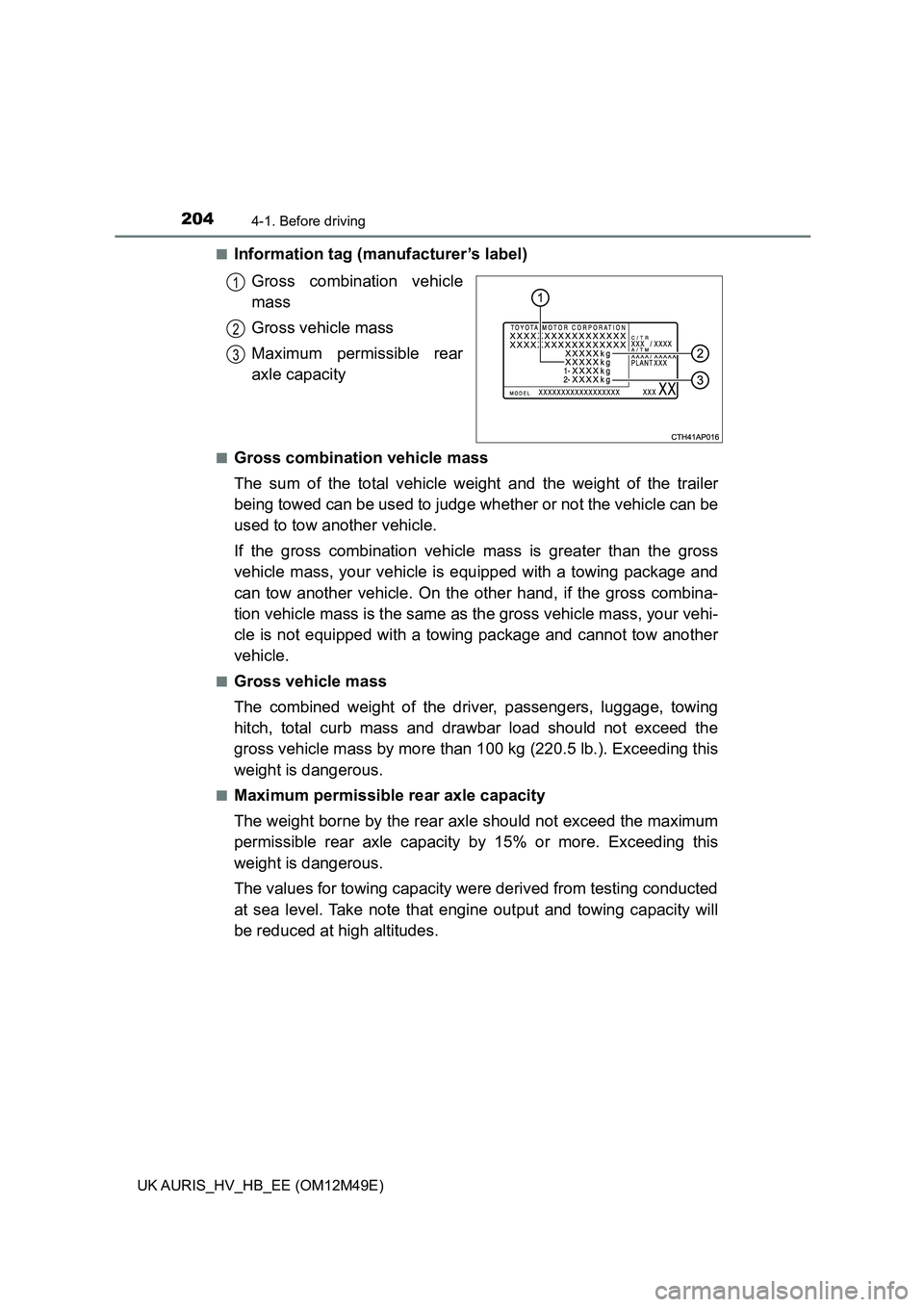
2044-1. Before driving
UK AURIS_HV_HB_EE (OM12M49E)
■Information tag (manufacturer’s label)
Gross combination vehicle
mass
Gross vehicle mass
Maximum permissible rear
axle capacity
■Gross combination vehicle mass
The sum of the total vehicle weight and the weight of the trailer
being towed can be used to judge whether or not the vehicle can be
used to tow another vehicle.
If the gross combination vehicle mass is greater than the gross
vehicle mass, your vehicle is e quipped with a towing package and
can tow another vehicle. On the other hand, if the gross combina-
tion vehicle mass is the same as the gross vehicle mass, your vehi-
cle is not equipped with a towing package and cannot tow another
vehicle.
■Gross vehicle mass
The combined weight of the driver, passengers, luggage, towing
hitch, total curb mass and drawbar load should not exceed the
gross vehicle mass by more than 100 kg (220.5 lb.). Exceeding this
weight is dangerous.
■Maximum permissible rear axle capacity
The weight borne by the rear ax le should not exceed the maximum
permissible rear axle capacity by 15% or more. Exceeding this
weight is dangerous.
The values for towing capacity were derived from testing conducted
at sea level. Take note that e ngine output and towing capacity will
be reduced at high altitudes.
1
2
3
Page 207 of 592

2074-1. Before driving
UK AURIS_HV_HB_EE (OM12M49E)
4
Driving
■Tire information
● Increase the tire inflation pressure to 20.0 kPa (0.2 kgf/cm2 or bar, 3 psi)
greater than the recommended value when towing. ( P. 560)
● Increase the air pressure of the trailer tires in accordance with the total
trailer weight and according to the values recommended by the manufac-
turer of your trailer.
■ Trailer lights
Please consult at any authorized dealer or repairer, or another duly qualified
and equipped professional when installing trailer lights, as incorrect installa-
tion may cause damage to the vehicle’s lights. Please take care to comply
with your state’s laws when installing trailer lights.
■ Break-in schedule
Toyota recommends that vehicles fitted with new power train components
should not be used for towing trailers for the first 800 km (500 miles).
■ Safety checks before towing
● Check that the maximum load limit for the towing hitch/bracket and hitch ball
is not exceeded. Bear in mind that the coupling weight of the trailer will add
to the load exerted on the vehicle. Also make sure that the total load exerted
on the vehicle is within the range of the weight limits. ( P. 203)
● Ensure that the trailer load is secure.
● Supplementary outside rear view mirrors should be added to the vehicle if
the traffic behind cannot be clearly seen with standard mirrors. Adjust the
extending arms of these mirrors on both sides of the vehicle so that they
always provide maximum visibility of the road behind.
■ Maintenance
● Maintenance must be performed more frequently when using the vehicle for
towing due to the greater weight burden placed on the vehicle compared to
normal driving.
● Retighten all bolts securing the hitching ball and bracket after towing for
approximately 1000 km (600 miles).
Page 210 of 592
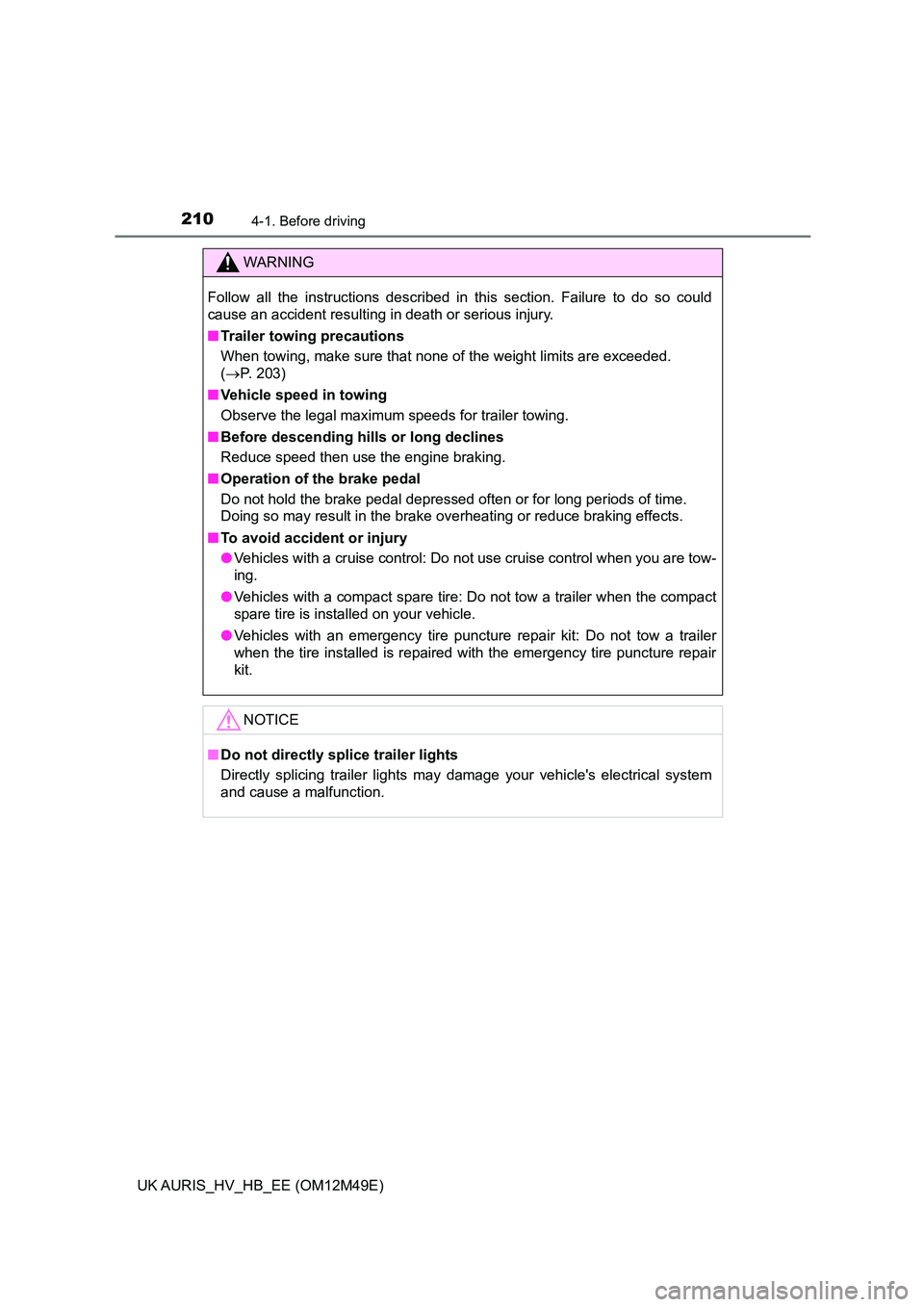
2104-1. Before driving
UK AURIS_HV_HB_EE (OM12M49E)
WARNING
Follow all the instructions described in this section. Failure to do so could
cause an accident resulting in death or serious injury.
■ Trailer towing precautions
When towing, make sure that none of the weight limits are exceeded.
( P. 203)
■ Vehicle speed in towing
Observe the legal maximum speeds for trailer towing.
■ Before descending hills or long declines
Reduce speed then use the engine braking.
■ Operation of the brake pedal
Do not hold the brake pedal depressed often or for long periods of time.
Doing so may result in the brake overheating or reduce braking effects.
■ To avoid accident or injury
● Vehicles with a cruise control: Do not use cruise control when you are tow-
ing.
● Vehicles with a compact spare tire: Do not tow a trailer when the compact
spare tire is installed on your vehicle.
● Vehicles with an emergency tire puncture repair kit: Do not tow a trailer
when the tire installed is repaired with the emergency tire puncture repair
kit.
NOTICE
■ Do not directly splice trailer lights
Directly splicing trailer lights may damage your vehicle's electrical system
and cause a malfunction.
Page 440 of 592
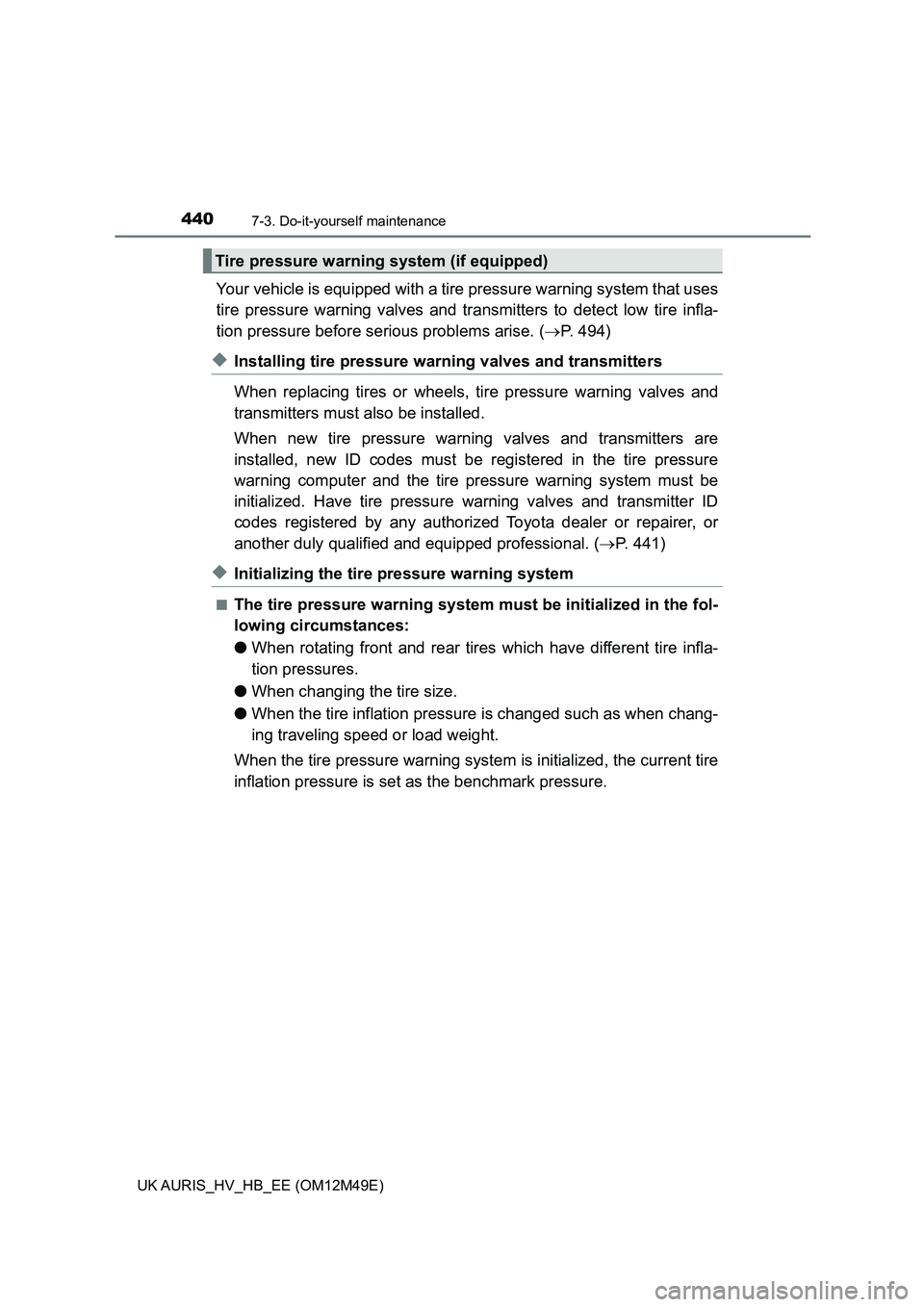
4407-3. Do-it-yourself maintenance
UK AURIS_HV_HB_EE (OM12M49E)
Your vehicle is equipped with a tire pressure warning system that uses
tire pressure warning valves and tr ansmitters to detect low tire infla-
tion pressure before serious problems arise. ( P. 494)
◆Installing tire pressure warning valves and transmitters
When replacing tires or wheels, tire pressure warning valves and
transmitters must also be installed.
When new tire pressure warning valves and transmitters are
installed, new ID codes must be registered in the tire pressure
warning computer and the tire pr essure warning system must be
initialized. Have tire pressure warning valves and transmitter ID
codes registered by any authoriz ed Toyota dealer or repairer, or
another duly qualified and equipped professional. ( P. 441)
◆Initializing the tire pressure warning system
■The tire pressure warning system must be initialized in the fol-
lowing circumstances:
● When rotating front and rear tires which have different tire infla-
tion pressures.
● When changing the tire size.
● When the tire inflation pressure is changed such as when chang-
ing traveling speed or load weight.
When the tire pressure warning system is initialized, the current tire
inflation pressure is set as the benchmark pressure.
Tire pressure warning system (if equipped)
Page 454 of 592

4547-3. Do-it-yourself maintenance
UK AURIS_HV_HB_EE (OM12M49E)
■ Instructions for checking tire inflation pressure
When checking tire inflation pressure, observe the following:
● Check only when the tires are cold.
If your vehicle has been parked for at least 3 hours or has not been driven
for more than 1.5 km or 1 mile, you will get an accurate cold tire inflation
pressure reading.
● Always use a tire pressure gauge.
It is difficult to judge if a tire is properly inflated based only on its appear-
ance.
● It is normal for the tire inflation pressure to be higher after driving as heat is
generated in the tire. Do not reduce tire inflation pressure after driving.
● Passengers and luggage weight should be placed so that the vehicle is bal-
anced.
WARNING
■ Proper inflation is critical to save tire performance
Keep your tires properly inflated.
If the tires are not properly inflated, the following conditions may occur
which could lead to an accident resulting in death or serious injury:
● Excessive wear
● Uneven wear
● Poor handling
● Possibility of blowouts resulting from overheated tires
● Air leaking from between tire and wheel
● Wheel deformation and/or tire damage
● Greater possibility of tire damage while driving (due to road hazards,
expansion joints, sharp edges in the road, etc.)
NOTICE
■ When inspecting and adjusting tire inflation pressure
Be sure to put the tire valve caps back on.
If a valve cap is not installed, dirt or moisture may get into the valve and
cause an air leak, resulting in decreased tire inflation pressure.
Page 455 of 592
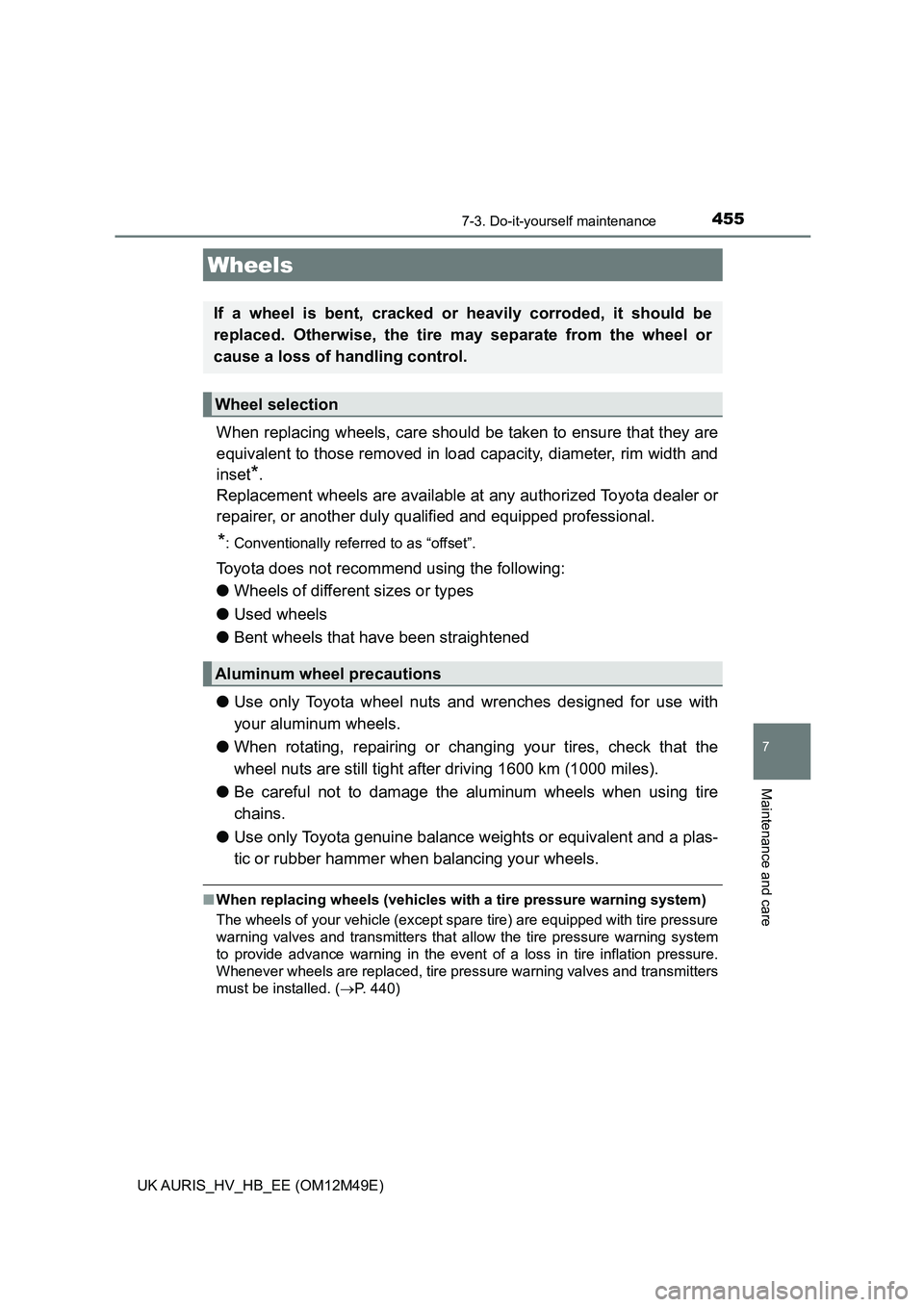
4557-3. Do-it-yourself maintenance
UK AURIS_HV_HB_EE (OM12M49E)
7
Maintenance and care
When replacing wheels, care should be taken to ensure that they are
equivalent to those removed in load capacity, diameter, rim width and
inset*.
Replacement wheels are available at any authorized Toyota dealer or
repairer, or another duly qua lified and equipped professional.
*: Conventionally referred to as “offset”.
Toyota does not recommend using the following:
● Wheels of different sizes or types
● Used wheels
● Bent wheels that have been straightened
● Use only Toyota wheel nuts and wrenches designed for use with
your aluminum wheels.
● When rotating, repairing or changing your tires, check that the
wheel nuts are still tight after driving 1600 km (1000 miles).
● Be careful not to damage the aluminum wheels when using tire
chains.
● Use only Toyota genuine balance weights or equivalent and a plas-
tic or rubber hammer when balancing your wheels.
■ When replacing wheels (vehicles with a tire pressure warning system)
The wheels of your vehicle (except spare tire) are equipped with tire pressure
warning valves and transmitters that allow the tire pressure warning system
to provide advance warning in the event of a loss in tire inflation pressure.
Whenever wheels are replaced, tire pressure warning valves and transmitters
must be installed. ( P. 440)
Wheels
If a wheel is bent, cracked or heavily corroded, it should be
replaced. Otherwise, the tire may separate from the wheel or
cause a loss of handling control.
Wheel selection
Aluminum wheel precautions
Page 552 of 592
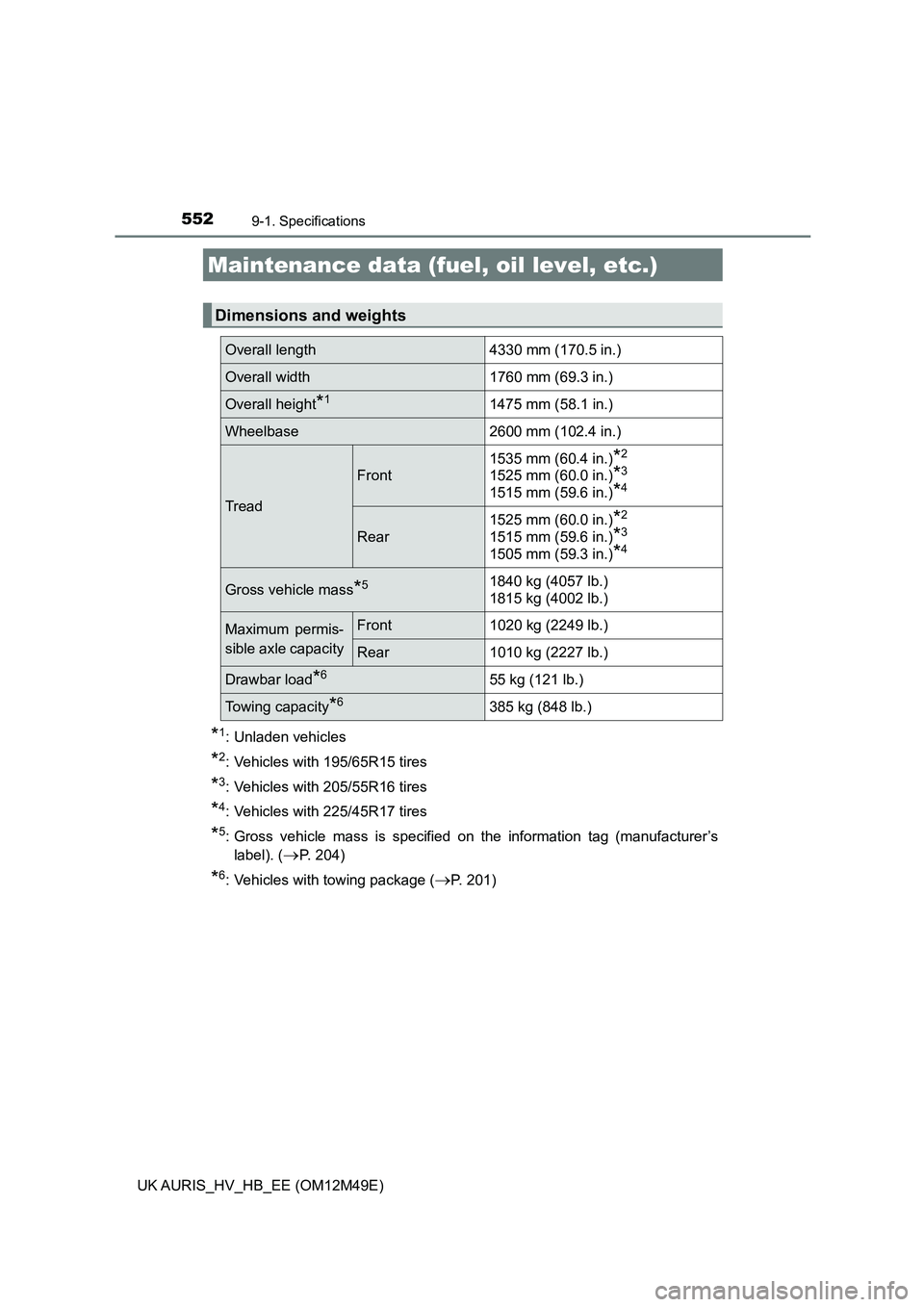
552
UK AURIS_HV_HB_EE (OM12M49E)
9-1. Specifications
*1: Unladen vehicles
*2: Vehicles with 195/65R15 tires
*3: Vehicles with 205/55R16 tires
*4: Vehicles with 225/45R17 tires
*5: Gross vehicle mass is specified on the information tag (manufacturer’s
label). (P. 204)
*6: Vehicles with towing package (P. 201)
Maintenance data (f uel, oil level, etc.)
Dimensions and weights
Overall length 4330 mm (170.5 in.)
Overall width 1760 mm (69.3 in.)
Overall height*11475 mm (58.1 in.)
Wheelbase 2600 mm (102.4 in.)
Tread
Front
1535 mm (60.4 in.)*2
1525 mm (60.0 in.)*3
1515 mm (59.6 in.)*4
Rear
1525 mm (60.0 in.)*2
1515 mm (59.6 in.)*3
1505 mm (59.3 in.)*4
Gross vehicle mass*51840 kg (4057 lb.)
1815 kg (4002 lb.)
Maximum permis-
sible axle capacity
Front 1020 kg (2249 lb.)
Rear 1010 kg (2227 lb.)
Drawbar load*655 kg (121 lb.)
Towing capacity*6385 kg (848 lb.)
Page 573 of 592
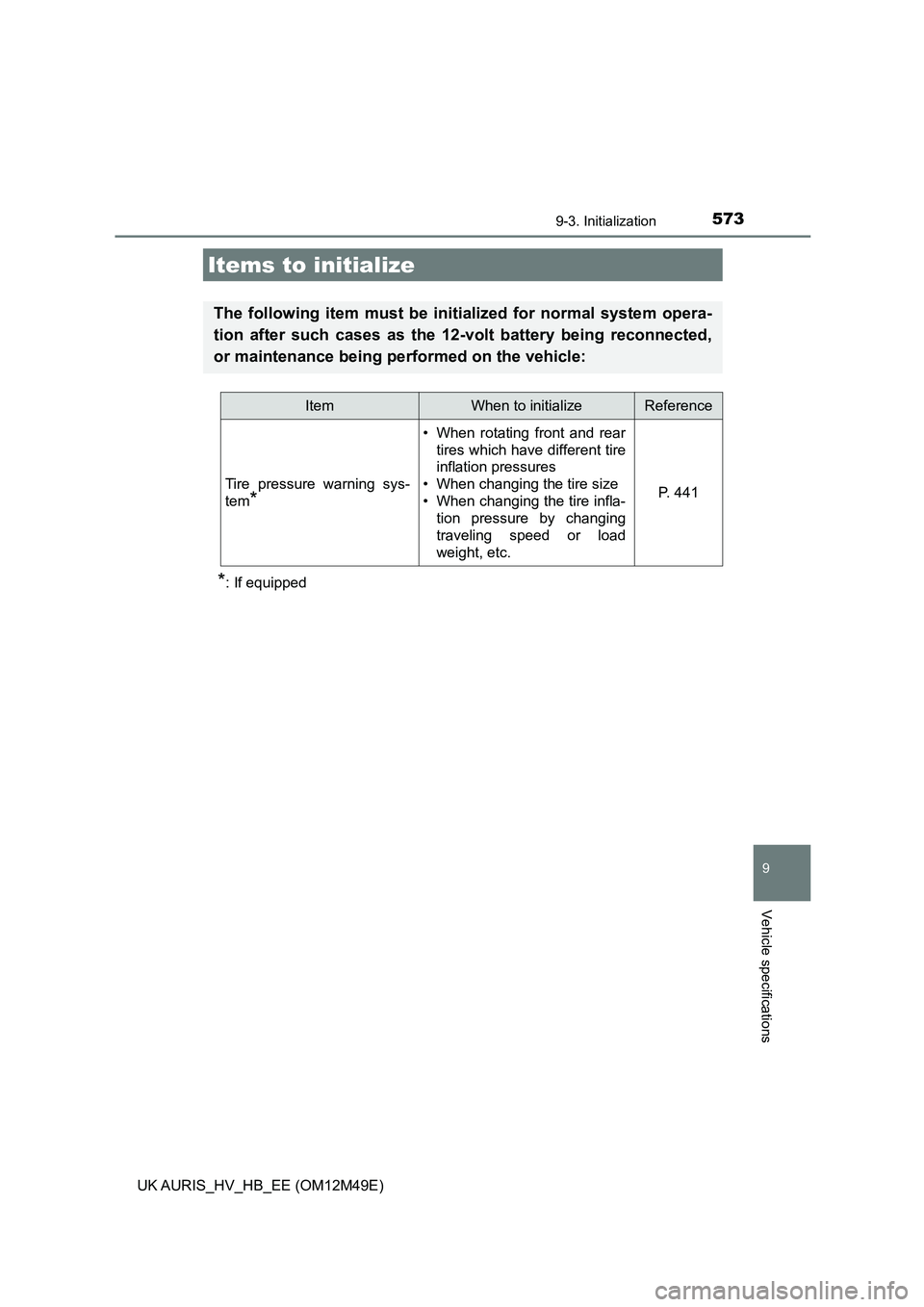
573
UK AURIS_HV_HB_EE (OM12M49E)
9
Vehicle specifications
9-3. Initialization
*: If equipped
Items to initialize
The following item must be initialized for normal system opera-
tion after such cases as the 12-volt battery being reconnected,
or maintenance being performed on the vehicle:
ItemWhen to initializeReference
Tire pressure warning sys-
tem*
• When rotating front and rear
tires which have different tire
inflation pressures
• When changing the tire size
• When changing the tire infla-
tion pressure by changing
traveling speed or load
weight, etc.
P. 441